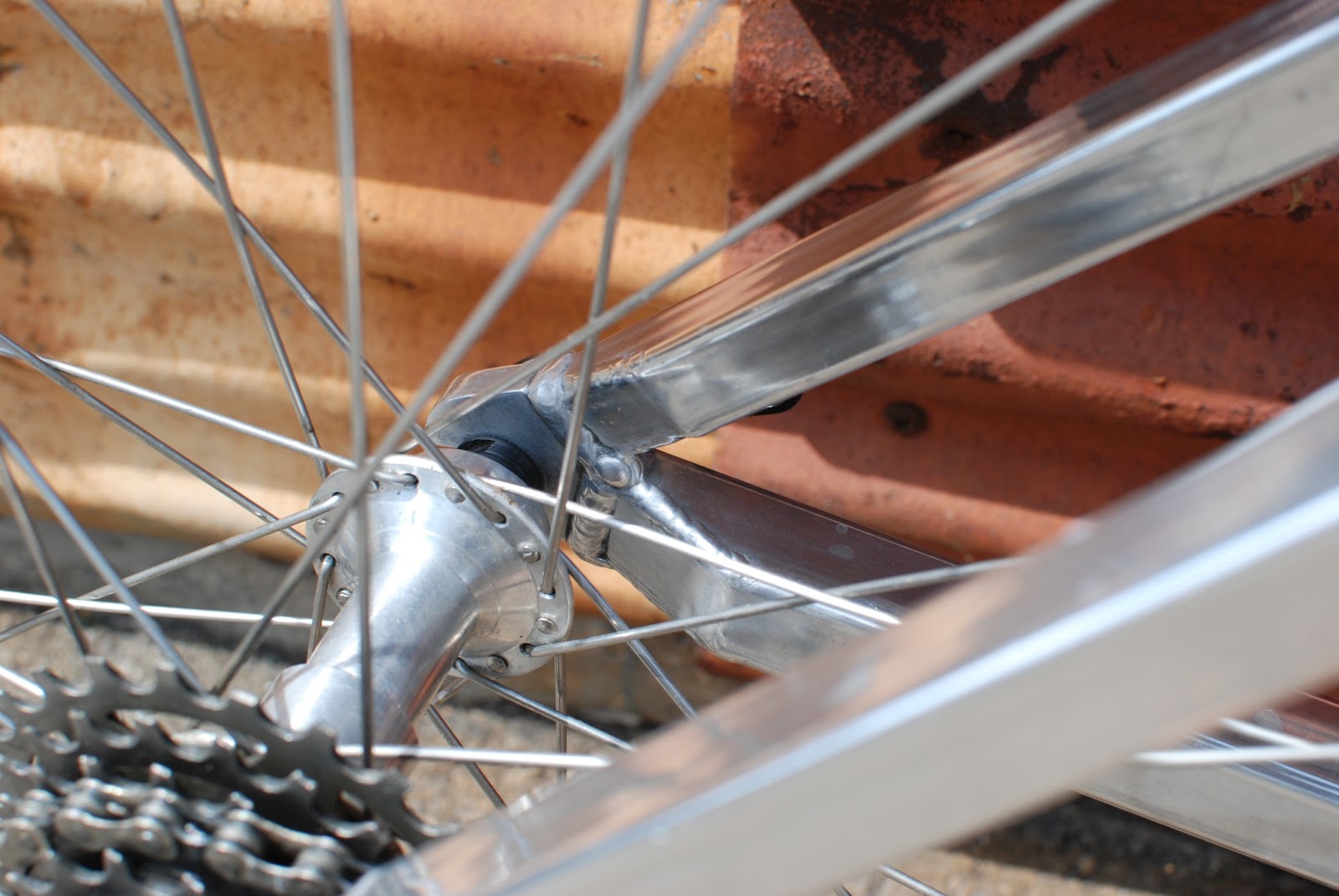First things first, frame specs.
Frame material 6061 T6 Aluminum, fork material 4130 CroMo
Top tube diameter: 1.5"
Seat tube diameter: 1.25" (26.8mm post)
Down tube diameter: 1.75"
Seat stays: 0.75 box section
Chain stays: 1.0" box section
Drop outs: 0.375" plate
BB Shell: 68mm
Rear axle spacing: 145mm
Front axle spacing: 115mm
Roller cam / u-brake mounts front and rear
I don't have an inclinometer to mesure the precise angles of the head and seat tubes, but the bike has an agressive feel to it, so my bet is they're somewhere in the low 70s.
Unlike my 1989 and 1990 DBMs which are virtually identical this bike has a host of unique features, a true testament to the idea that Doug was experimenting with design elements along the way and some things stuck around while others were changed.
One of the neater features in my opinion is the design and construction of the chainstay to bottom bracket shell joint. On this early frame the non drive side chainstay is made out of a 2 piece 1" box section angled away from the BB shell to provide tire clearance. This bike came with Fisher Fattrax 1.9 tires which fit nicely, but I think running the same tire in a 2.2" version would be a stretch. To provide tire clearance and align the chainline for the oversize rear hub drive side chainstay is shaved off to approximately 0.75" wide and angled. The later 89/90 frames used 3/8" Aluminum stock in lieu of the formed 1.0" section to join the main section of the stays to the BB shell. Also this frame lacks the horizontal cross member joining the two seatstays that is present on the later frames.
Couple more photos showing the details of the stays and the horizontal dropouts on this frame.
Unlike the 89 and 90 frames which run rear brake and rear derailleur cables along the top of the top tube the 88 runs the rear brake cable underneath the top tube and both the front and rear derailleur underneath the down tube. Due to the routing and size of the frame I had to trim down some housing ferrules to enable the cables to have a more relaxed bend and not push too much against the ferrules.
Due to the frames small size not a lot of room is available for the straddle cable on the rear brake. The solution (as was the way back then) is a modified straddle cable hanger. The top of the hanger was shaved off and the hole moved down closer to the bottom to allow for a shorter pull on the rear brake cable. I think the rear brake stiffener is a bit overkill in this application, but it does look the part!
This bike has probably one of the early examples of Doug's composite Aluminum and Steel forks. Using a bolt on Aluminum crown and 1.125" 4130 steel legs he was able to provide a fork both stiff and lightweight. The lower legs of the fork are pressed together to enable the attachment of the dropouts (I'll add a photo later on), this is rather unique and early attempt at this. By 1989 he seems to have improved the method and those later forks do not have the odds bulge at the bottom like this one.
Although difficult to see this early fork uses plastic top caps instead of the later adopted Aluminum caps that became very common with the introduction of the Manitou suspension fork.
In terms of the component spec this bike has just about the best that time period could offer. Cranks and Titanium bottom bracket courtesy of Cook Brothers (RSR cranks shown in photos will be swapped for period correct CBR cranks). IRD progressive u-brakes, seatpost and handlebar combined with a Ringle stem were some of the more exciting components back then. The Ringle stem was a 1989 feature and will most likely be swapped out for an original Manitou or maybe a matching IRD macaroni. Front and rear wheels are custom modified by Doug using an extended Hi-E front and XT rear hub to accomodate the wider spacing. Rims are Ritchey Vantage Comp and tires are Fisher Fattrax 1.9 (sometimes called Slimtrax). Drivetrain is mostly Shimano XT M730, however this bike got a tighter rear cluster and thus employed a Shimano EX600 rear derailleur to provide crisp rear shifting. Originally the bike was equipped with smaller front rings resulting in a sort of early micro-drive type setup. I replaced these with a more standard 48/36/24 spread, but this setup seems to require some adjustment to the chainline, so I may have to make a few more adjustments here.
All in all the bike is a fantastic, it really must have a been a treat to bring this home back in 1988. Unlike some of the later Manitous the finish on this frame is amazing even after all these years. The bike simply looks amazing and feels as good as anything else I've ridden from that time period. It's been a real pleasure restoring this frame and I hope it continues to see real trails for another 20+ years.













Hey we were just reading your article trying to find more on my dads bike which is a model like this 3 years older. We are trying to find out more about it ! if you have an email we could talk about it. That would be great. Thanks
ReplyDeleteSure, I'd be happy to help out. Please contact me at secondspincycles@gmail.com
DeleteYou can also get in touch with me via the contact form on the front page of my blog.
Delete